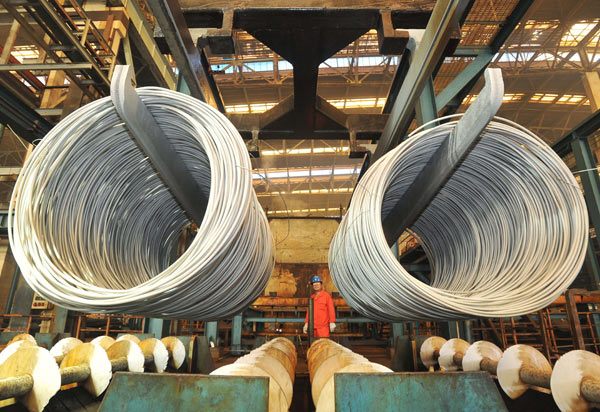Latin America easing China steel glut
Updated: 2014-08-11 05:40
By AMY HE in New York (China Daily USA)
|
|||||||||
 |
|
With infrastructure projects booming, Latin America has been buying more steel from China, which is coping with surpluses. [Photo/Provided to China Daily] |
China exported 4 million metric tons of finished steel to Latin America in the first half of 2014, making the region the second-biggest destination of Chinese exports as China-Latin America trade continues to grow.
The amount exported to Latin America from January to June is 65 percent more than the export amount recorded in the same period last year, according to SteelGuru, a metals commodities research website.
Brazil, Mexico and Chile are the main destinations for China's steel, and flat products — sheets and coils of metal products — make up 67 percent of China's exports to Latin America, SteelGuru said.
"The flow of Chinese steel to the world continues to grow steadily, a trend that gets even more marked for the case of Latin America. Latin America accounts for 5 percent of the world's finished steel consumption. However, the region currently represents 11 percent of the Chinese exports of such products and its share grew 2 percentage points (from 9 percent) during the last year," it said.
For the last decade, China sourced many of its required raw commodities from Latin America — iron from Brazil and copper from Chile — but now the reverse is happening with Latin American countries relying on steel in large quantities from China, much of it due to Latin America's urbanization, said Erik Bethel, managing director at Darby Private Equity.
"The infrastructure needs that Latin America has are enormous. Brazil in particular is building ports and rail lines and all sorts of infrastructure that require a lot of steel. Brazil acutely realizes the infrastructure shortfall that they have, and as a result, they need more steel," Bethel told China Daily.
The steel is being used predominantly in infrastructure, railways and the auto sector, Bethel said. Countries in Latin America used to source steel domestically since there were a number of steel mills in Brazil and Argentina, but have since turned to importing products from China. Conversely, an excess of steel in China is driving exports out of the country, he said.
"Right now, China has a glut," Bethel said. "Steel mills in China have excess capacity and Latin America is a natural market, so the amount of steel imported by China into Latin America has grown exponentially in the last several years. That's really a new phenomenon, and it's driven by an excessive amount of production in China over the last two or three years."
Though experts have said that China is on track to meet its 7.5 percent GDP growth target for 2014, the economy has slowed down, impacting infrastructure and property development and weakening domestic demand for commodities like steel.
Exports to foreign countries are helping offset the glut, and with Latin America, free trade agreements between the two regions are helping expedite Chinese exports and foreign direct investment into the region as well, Bethel said.
"There's no question that Latin America with its 560-570 million people is a very important destination for Chinese export products — be they consumer electronics, or white goods, or autos, textiles," he said. "In a reverse, China is importing from Brazil a tremendous amount of iron ore, oil and soybeans. So trade between these regions is only going to expand as China continues its urbanization and as Latin American also urbanizes and grows its middle class."
amyhe@chinadailyusa.com
Most Viewed
Editor's Picks

|

|

|

|

|

|
Today's Top News
Many Chinese economic fugitives still at large in US
China's Huawei shows interest in LatAm
Kerry: Formation of Iraqi govt critical for stability
Shooting leaves 2 dead, 5 injured in New Orleans
Police focus on emigrants who still have their hukou
Chinese Ebola doctors leave for Africa
At least 39 killed in Tehran jet crash
US is top destination for Chinese fugitives
US Weekly

|

|
















